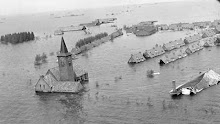Heaton Park was a large camp for RAF personnel awaiting posting overseas, where I was stationed for about ten days. I had said goodbye to my family during my embarkation leave and was sustained, like many others, by the popular songs that promised reunion in better times. My best-loved singer was Vera Lynn. I had been called up (drafted) into the Royal Air Force (RAF) the previous November. I knew that I was going to the Middle East but had no idea where or what adventures awaited. I had never left England previously.
Apart from meals and parades for roll call, the main activity was waiting, so I fitted in occasional periods of my hobby. On this day I recorded:
“Walked to a sewage farm about 2-3 miles W of park. Saw almost nothing - c. 8 Moorhens feeding on one tank and a probable wader of Dunlin-Knot size at a great distance elsewhere."
It was not unusual for me to visit a sewage farm. My father had introduced me to birdwatching at about the age of ten and it had been my hobby since. Surprisingly, sewage farms are great places for birdwatching! The previous spring, I had spent a lot of time on Nottingham sewage farm, using my first pair of binoculars (8x30), and witnessed the first known breeding in the British Isles of Black-winged Stilts. In April 1945 the retreating German Army blew up the Zuider Zee sea-wall and flooded large parts of the Netherlands. Stilts normally bred there but were unable to do so because of the depth of water and some appeared across the North Sea on 13 May 1945. They stayed through the summer and successfully reared young.
Extract from British Birds 1945
I was an 18 year old student at University College Nottingham, taking an accelerated course in Engineering. I was dazzled by the exciting ornithological event that unfolded before my eyes, though completely unaware of the tragic situation across the North Sea that gave rise to the remarkable visit. Playing a part in an event of national prominence, gave me confidence as a birdwatcher and helped confirm it as my life interest.
Apart from their rarity in England, Black-winged Stilts are remarkable looking birds and I spent a lot of my time in the spring of 1945 observing them. I was not to know then that this would lead to the opportunity to see many more of them in the future, as well as other wonders. Visits to the sewage farm left me with less time to prepare for imminent examinations at the end of my first university year. I failed some of these exams in June 1945 and, even though the war finished two months later, was called up. Thus was launched the adventure described in this blog.>>>



